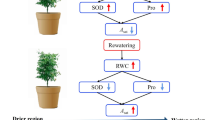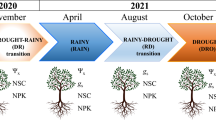Abstract
Aim
Efficient fog water utilization under soil drought conditions is important for improving the water status and growth of forest trees. However, importance of fog water retention for trees during drought is yet to be completely examined. The aim of this study was to examine changes in fog water retention in different organs of Japanese black pine (Pinus thunbergii) saplings under well-watered and drought conditions.
Methods
P. thunbergii saplings were grown under well-watered and drought conditions in a glasshouse for 19 days and exposed to 2 H-enriched water vapor under a high relative humidity (~ 95%) for 1 h in a growth chamber under a uniform light condition. The exposed trees were harvested 48 h after the fog exposure experiment and the 2 H concentration of water in current needles, old needles, current branches, old branches, roots, and soil was determined.
Results
Absorbed fog water was detected in the needles, branches, and roots 48 h after exposure to fog. The amount of water in the current needles, old needles, and current branches contributed by fog water was significantly higher in drought-stressed trees than in well-irrigated trees. Small amount of absorbed fog water was redistributed to the soil, irrespective of soil water conditions.
Conclusion
We found that larger amount of absorbed fog water was retained in drought-stressed trees than that in well-watered trees, which may improve the water status of plants under drought. Our results also suggest that hydraulic redistribution from the roots to the soil may occur irrespective of soil drought conditions.




Similar content being viewed by others
References
Allison GB, Barnes CJ, Hughes MW (1983) The distribution of deuterium and 18O in dry soils 2. Experimental J Hydrol 64:377–397. https://doi.org/10.1016/0022-1694(83)90078-1
Barbeta A, Gimeno TE, Clavé L, Fréjaville B, Jones SP, Delvigne C, Wingate L, Ogée J (2020) An explanation for the isotopic offset between soil and stem water in a temperate tree species. New Phytol 227:766–779. https://doi.org/10.1111/nph.16564
Belot Y, Gauthier D, Camus H, Caput C (1979) Prediction of the flux of tritiated water from air to plant leaves. Health Phys 37:575–583
Berry ZC, Emery NC, Gotsch SG, Goldsmith GR (2019) Foliar water uptake: processes, pathways, and integration into plant water budgets. Plant Cell Environ 42:410–423. https://doi.org/10.1111/pce.13439
Binks O, Coughlin I, Mencuccini M, Meir P (2020) Equivalence of foliar water uptake and stomatal conductance? Plant Cell Environ 43:524–528. https://doi.org/10.1111/pce.13663
Binks O, Mencuccini M, Rowland L, Da Costa AC, De Carvalho CJR, Bittencourt P, Eller C, Teodoro GS, Carvalho EJM, Soza A, Ferreira L (2019) Foliar water uptake in amazonian trees: evidence and consequences. Glob Chang Biol 25:2678–2690. https://doi.org/10.1111/gcb.14666
Bond BJ, Kavanagh KL (1999) Stomatal behavior of four woody species in relation to leaf-specific hydraulic conductance and threshold water potential. Tree Physiol 19:503–510. https://doi.org/10.1093/treephys/19.8.503
Boucher JF, Munson AD, Bernier PY (1995) Foliar absorption of dew influences shoot water potential and root growth in Pinus strobus seedlings. Tree Physiol 15:819–823. https://doi.org/10.1093/treephys/15.12.819
Breshears DD, McDowell NG, Goddard KL, Dayem KE, Martens SN, Meyer CW, Brown KM (2008) Foliar absorption of intercepted rainfall improves woody plant water status most during drought. Ecology 89:41–47. https://doi.org/10.1890/07-0437.1
Burgess SSO, Dawson TE (2004) The contribution of fog to the water relations of Sequoia sempervirens (D. Don): foliar uptake and prevention of dehydration. Plant Cell Environ 27:1023–1034. https://doi.org/10.1111/j.1365-3040.2004.01207.x
Burkhardt J, Basi S, Pariyar S, Hunsche M (2012) Stomatal penetration by aqueous solutions–an update involving leaf surface particles. New Phytol 196:774–787. https://doi.org/10.1111/j.1469-8137.2012.04307.x
Carmichael MJ, White JC, Cory ST, Berry ZC, Smith WK (2020) Foliar water uptake of fog confers ecophysiological benefits to four common tree species of southeastern freshwater forested wetlands. Ecohydrology 13:e2240. https://doi.org/10.1002/eco.2240
Cassana FF, Eller CB, Oliveira RS, Dillenburg LR (2016) Effects of soil water availability on foliar water uptake of Araucaria angustifolia. Plant Soil 399147–399157. https://doi.org/10.1007/s11104-015-2685-0
Choi YH, Lim KM, Lee WY, Diabate S, Strack S (2002) Tissue free water tritium and organically bound tritium in the rice plant acutely exposed to atmospheric HTO vapor under semi-outdoor conditions. J Environ Radioact 58:67–85. https://doi.org/10.1016/S0265-931X(01)00024-8
Cobos D, Campbell C (2007) Correcting temperature sensitivity of ECH2O soil moisture sensors: application note. Decagon Devices, Pullman
Dawson TE (1998) Fog in the California redwood forest: ecosystem inputs and use by plants. Oecologia 117:476–485. https://doi.org/10.1007/s004420050683
Dawson TE, Goldsmith GR (2018) The value of wet leaves. New Phytol 219:1156–1169. https://doi.org/10.1111/nph.15307
Dawson TE, Mambelli S, Plamboeck AH, Templer PH, Tu KP (2002) Stable isotopes in plant ecology. Annu Rev Ecol Syst 33:507–559. https://doi.org/10.1146/annurev.ecolsys.33.020602.095451
Eamus D, Prior LD (2001) Ecophysiology of trees of seasonally dry tropics: comparisons among phenologies. Adv Ecol Res 32:113–197. https://doi.org/10.1016/S0065-2504(01)32012-3
Eller CB, Lima AL, Oliveira RS (2013) Foliar uptake of fog water and transport belowground alleviates drought effects in the cloud forest tree species, Drimys brasiliensis (W interaceae). New Phytol 199:151–162. https://doi.org/10.1111/nph.12248
Eller CB, Lima AL, Oliveira RS (2016) Cloud forest trees with higher foliar water uptake capacity and anisohydric behavior are more vulnerable to drought and climate change. New Phytol 211:489–501. https://doi.org/10.1111/nph.13952
Ellsworth PZ, Williams DG (2007) Hydrogen isotope fractionation during water uptake by woody xerophytes. Plant Soil 291:93–107. https://doi.org/10.1007/s11104-006-9177-1
Fernández V, Sancho-Knapik D, Guzmán P, Peguero-Pina JJ, Gil L, Karabourniotis G, Khayet M, Fasseas C, Heredia-Guerrero JA, Heredia A, Gil-Pelegrín E (2014) Wettability, polarity, and water absorption of holm oak leaves: effect of leaf side and age. Plant Physiol 166:168–180. https://doi.org/10.1104/pp.114.242040
Fischer DT, Still CJ, Ebert CM, Baguskas SA, Park Williams A (2016) Fog drip maintains dry season ecological function in a California coastal pine forest. Ecosphere 7:e01364. https://doi.org/10.1002/ecs2.1364
Gerber HE (1981) Microstructure of a radiation fog. J Atmos Sci 38:454–458. https://doi.org/10.1175/1520-0469(1981)038<0454:MOARF>2.0.CO;2
Goldsmith GR (2013) Changing directions: the atmosphere–plant–soil continuum. New Phytol 199:4–6. https://doi.org/10.1111/nph.12332
Goldsmith GR, Matzke NJ, Dawson TE (2013) The incidence and implications of clouds for cloud forest plant water relations. Ecol Let 16:307–314. https://doi.org/10.1111/ele.12039
Guenot J, Belot Y (1984) Assimilation of 3H in photosynthesing leaves exposed to HTO. Health Phys 47:849–855
Guzmán-Delgado P, Earles JM, Zwieniecki MA (2018) Insight into the physiological role of water absorption via the leaf surface from a rehydration kinetics perspective. Plant Cell Environ 41:1886–1894. https://doi.org/10.1111/pce.13327
Hayes MA, Chapman S, Jesse A, O’Brien E, Langley JA, Bardou R, Devaney J, Parker JD, Cavanaugh KC (2020) Foliar water uptake by coastal wetland plants: a novel water acquisition mechanism in arid and humid subtropical mangroves. J Ecol 108:2625–2637. https://doi.org/10.1111/1365-2745.13398
Inoue (1992) Meteorological properties of sea fog induced by yamase (in japanese). Tenki 39:459–467
Irvine J, Perks MP, Magnani F, Grace J (1998) The response of Pinus sylvestris to drought: stomatal control of transpiration and hydraulic conductance. Tree Physiol 18:393–402. https://doi.org/10.1093/treephys/18.6.393
Kerstiens G (1996) Cuticular water permeability and its physiological significance. J Exp Bot 47:1813–1832. https://doi.org/10.1093/jxb/47.12.1813
Kimoto M, Yasutomi N, Yokoyama C, Emori S (2005) Projected changes in precipitation characteristics around Japan under the global warming. Sola 1:85–88. https://doi.org/10.2151/sola.2005-023
Lai CT, Ehleringer JR (2011) Deuterium excess reveals diurnal sources of water vapor in forest air. Oecologia 165:213–223. https://doi.org/10.1007/s00442-010-1721-2
Lebourgeois F, Lévy G, Aussenac G, Clerc B, Willm F (1998) Influence of soil drying on leaf water potential, photosynthesis, stomatal conductance and growth in two black pine varieties. Ann Sci For 55:287–299. https://doi.org/10.1051/forest:19980302
Lehmann MM, Goldsmith GR, Schmid L, Gessler A, Saurer M, Siegwolf RT (2018) The effect of 18O-labelled water vapour on the oxygen isotope ratio of water and assimilates in plants at high humidity. New Phytol 217:105–116. https://doi.org/10.1111/nph.14788
Limm EB, Dawson TE (2010) Polystichum munitum (Dryopteridaceae) varies geographically in its capacity to absorb fog water by foliar uptake within the redwood forest ecosystem. Am J Bot 97:1121–1128. https://doi.org/10.3732/ajb.1000081
Limm EB, Simonin KA, Bothman AG, Dawson TE (2009) Foliar water uptake: a common water acquisition strategy for plants of the redwood forest. Oecologia 161:449–459. https://doi.org/10.1007/s00442-009-1400-3
Mitsuishi S, Mizoguchi M (2014) Calibration of the capacitance type of ECH2O soil moisture sensors (in japanese with English abstract). Soil Phys Cond Plant Growth Jpn 126:63–70
Nobel PS (1999) Physicochemical and environmental plant physiology, 2nd edn. Academic, San Diego
Oguchi S, Fujibe F (2012) Seasonal and regional features of long-term precipitation changes in Japan. Pap Meteorol Geophys 63:21–30. https://doi.org/10.2467/mripapers.63.21
Prieto I, Armas C, Pugnaire FI (2012) Water release through plant roots: new insights into its consequences at the plant and ecosystem level. New Phytol 193:830–841. https://doi.org/10.1111/j.1469-8137.2011.04039.x
Pruppacher HR, Klett JD (1997) Microphysics of clouds and precipitation. Kluwer Academic Publishers, Dordrecht
Simonin KA, Santiago LS, Dawson TE (2009) Fog interception by Sequoia sempervirens (D. Don) crowns decouples physiology from soil water deficit. Plant Cell Environ 32:882–892. https://doi.org/10.1111/j.1365-3040.2009.01967.x
Umebayashi T, Morita T, Utsumi Y, Kusumoto D, Yasuda Y, Haishi T, Fukuda K (2016) Spatial distribution of xylem embolisms in the stems of Pinus thunbergii at the threshold of fatal drought stress. Tree Physiol 36:1210–1218. https://doi.org/10.1093/treephys/tpw050
Van Genuchten MT (1980) A closed-form equation for predicting the hydraulic conductivity of unsaturated soils. Soil Sci Soc Am J 44:892–898. https://doi.org/10.2136/sssaj1980.03615995004400050002x
Wang A, Siegwolf RT, Joseph J, Thomas FM, Werner W, Gessler A, Rigling A, Schaub M, Saurer M, Li MH, Lehmann MM (2021) Effects of soil moisture, needle age and leaf morphology on carbon and oxygen uptake, incorporation and allocation: a dual labeling approach with 13CO2 and H218O in foliage of a coniferous forest. Tree Physiol 41:50–62. https://doi.org/10.1093/treephys/tpaa114
Warren JM, Brooks JR, Meinzer FC, Eberhart JL (2008) Hydraulic redistribution of water from Pinus ponderosa trees to seedlings: evidence for an ectomycorrhizal pathway. New Phytol 178:382–394. https://doi.org/10.1111/j.1469-8137.2008.02377.x
Acknowledgements
We thank Dr. Y. Ishikawa at the Institute for Environmental Sciences (IES) for helping in measuring the hydrogen isotope ratio in the extracted water samples. We thank Dr. T. Tani for the internal review for the manuscript. We also thank the three anonymous reviewers for their contributions to improve the manuscript.
Funding
This work was supported by the Japan Society for the Promotion of Science (JSPS) KAKENHI (Grant Number JP 17K15290 to S.I).
Author information
Authors and Affiliations
Contributions
S.I. conceived and designed the research; S.I. and H.K. performed water extraction using a cryogenic vacuum extraction system; M.N. provided data on the relationships between VWC and pF of the soil; S.I. collected and analyzed the data and wrote the manuscript; all authors have read the manuscript and commented on it.
Corresponding author
Ethics declarations
Conflict of interest
The authors declare that they have no conflicts of interest.
Additional information
Responsible Editor: Rafael S. Oliveira.
Publisher’s note
Springer Nature remains neutral with regard to jurisdictional claims in published maps and institutional affiliations.
Supplementary information
Below is the link to the electronic supplementary material.
ESM 1
(DOCX 3.50 MB)
Rights and permissions
Springer Nature or its licensor (e.g. a society or other partner) holds exclusive rights to this article under a publishing agreement with the author(s) or other rightsholder(s); author self-archiving of the accepted manuscript version of this article is solely governed by the terms of such publishing agreement and applicable law.
About this article
Cite this article
Imada, S., Kakiuchi, H. & Nagai, M. Soil drought increases the retention time of plant water in Pinus thunbergii saplings. Plant Soil 489, 667–679 (2023). https://doi.org/10.1007/s11104-023-06053-z
Received:
Accepted:
Published:
Issue Date:
DOI: https://doi.org/10.1007/s11104-023-06053-z




